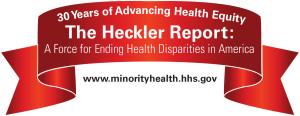30 Years of Health Disparities in Focus during National Minority Health Month
April is National Minority Health Month, a time to raise awareness about the health disparities that continue to affect minority populations. The observance traces its roots to a landmark 1985 report from the U.S. Department of Health and Human Services (HHS) that documented the existence of health disparities among racial and ethnic minorities in the U.S. The report called such disparities “an affront to both our ideals and to the ongoing genius of American medicine.”
 Fast forward 30 years, and the HHS’s Office of Minority Health (established in 1986 and re-authorized in 2010 by the Affordable Care Act) continues its work to improve the health of racial and ethnic minority populations through the development of health policies and programs that will eliminate health disparities.
Fast forward 30 years, and the HHS’s Office of Minority Health (established in 1986 and re-authorized in 2010 by the Affordable Care Act) continues its work to improve the health of racial and ethnic minority populations through the development of health policies and programs that will eliminate health disparities.
What sort of health disparities exist in the U.S.? According to the Office of Minority Health:
- The death rate for African Americans is generally higher than for Whites for heart diseases, stroke, cancer, asthma, influenza and pneumonia, diabetes, HIV/AIDS and homicide. African American children are three times more likely to be admitted to the hospital for asthma than non-Hispanic White children, and African American adults are 70 percent more likely than non-Hispanic white adults to have been diagnosed with diabetes. In addition, fewer African Americans have health insurance than non-Hispanic Whites and are more likely to rely on Medicaid.
- American Indians and Alaska Natives have an infant death rate 60 percent higher than the rate for Whites. They are also twice as likely to have diabetes, and have a disproportionately high death rate from unintentional injuries and suicides. American Indians and Alaska Natives also frequently contend with issues that prevent them from receiving quality medical care, such as cultural barriers, geographic isolation, inadequate sewage disposal and low income.
- Tuberculosis is 24 times more common among Asians than for the non-Hispanic White population. Asian Americans also contend with numerous factors that may threaten their health: infrequent medical visits due to fear of deportation, language/cultural barriers, and the lack of health insurance.
- Hispanics have higher rates of obesity than non-Hispanic Whites. Puerto Ricans have a low birth weight rate that is twice that of non-Hispanic Whites. They also suffer disproportionately from asthma, HIV/AIDS and infant mortality. Mexican-Americans suffer disproportionately from diabetes. Hispanic health is often shaped by factors such as language/cultural barriers, lack of access to preventive care, and the lack of health insurance.
- Native Hawaiians and Pacific Islanders have higher rates of smoking, alcohol consumption and obesity compared with other ethnic groups. This group also has little access to cancer prevention and control programs.
To address these disparities, HHS in 2011 issued the HHS Action Plan to Reduce Racial and Ethnic Health Disparities. In the Action Plan, HHS points to the related benefits of the Affordable Care Act (ACA): “The Affordable Care Act not only includes provisions related broadly to health insurance coverage, health insurance reform, and access to care, but also provisions related to disparities reduction, data collection and reporting, quality improvement, and prevention. The [ACA] will also reduce health disparities by investing in prevention and wellness, and giving individuals and families more control over their own care.”
The Centers for Disease Control and Prevention are also on the front lines of advancing health equity with several programs in place that support the HHS Action Plan:
- In collaboration with the Centers for Medicare & Medicaid Services (CMS), CDC is leading the HHS-wide “Million Hearts Initiative” to enhance community and clinical interventions to prevent cardiovascular disease (CVD) and stroke among all Americans, including minority populations at greater risk for CVD.
- In the U.S., rates of childhood obesity are high overall, but for minority and low-income communities, they are even higher. The Childhood Obesity Research Demonstration (CORD) Project seeks to determine whether coordinated approaches in the community that support healthy behaviors can improve underserved children’s health.
- The CDC Undergraduate Public Health Scholars (CUPS) program supports internship programs that expose undergraduate students interested in minority health to the field of public health research and practice by providing hands-on, project-oriented assignments.
- The National Influenza Vaccination Disparities Partnership, supported by the CDC, is comprised of multi-sector partners working to promote vaccination among underserved populations including African Americans, Hispanics, and American Indians/Alaska Natives.
- CDC also continues to partner with states and other grantees to work on reducing tobacco use among racial and ethnic minorities.
Disparities also exist at the health care provider level. According to the NAACP’s Opportunity & Diversity Report Card: Healthcare Industry, released earlier this month, top management positions in health care remain firmly dominated by white employees, despite the establishment of diversity and inclusion programs and a significant increase in minority college graduates entering the workforce over the past 20 years.
“With the health care industry being one of the fastest growing sectors in the country, it is important for us to highlight opportunities in this industry and where we can strengthen people of color’s full participation,” said Roslyn M. Brock, chairman, NAACP Board of Directors, in a press statement.
Here at Real World Health Care, we believe that every American, regardless of race or ethnicity, should have access to affordable care and patient-centered prevention programs. We salute the efforts of governmental organizations, NGOs, health care providers and other groups working to eliminate health disparities.
Are you aware of any individual or group efforts to reduce health disparities? Let’s all learn from what is working. Please share your examples in the comments section.

















